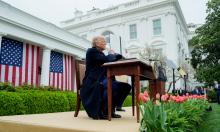Air crashes were a result of terrorist acts
Russia's security service said it found traces of explosives in the wreckage of both Russian planes that crashed on Tuesday night, killing 89 people. Hexogen, known in the U.S. as cyclonite, was found in the debris of the Tu-134 plane that crashed in the Tula region, near Moscow, said Sergei Ignachenko, spokesman for the Federal Security Service (FSB), on Russia's NTV television. The substance, used in attacks in Russia attributed to separatist rebels from Chechnya, was also found in the Tu-154 jet that crashed in the southern Rostov region close to the Ukrainian border, FSB spokesman Nikolai Zakharov said yesterday. An Islamist group said it was responsible. The timing of the crashes, before Sunday's presidential elections in Chechnya, prompted Russian media to suggest terrorists were at work. An Islamic group, calling itself the Islambouli Brigades, claimed responsibility for the hijacking and crashes of the planes in a statement published on an Arabic- language Web site. The crashes are Russia's biggest air disaster since July 2001, when pilot error caused a Tu-154 to crash as it prepared to land at Irkutsk, Siberia, killing all 145 people on board, informs Bloomberg. According to NYTimes, investigators found traces of explosives on the second of two passenger airliners that crashed simultaneously in Russia, security officials announced Saturday, confirming that they consider the twin air disasters to be terrorist acts. Facing a menacing turn in Russia's fight against terrorism and eager to calm travelers, the officials announced that they would increase security at the country's airports. The new measures included having Interior Ministry officers screen passengers, starting immediately, and installing sensors able to detect the presence of explosives. Sergei N. Ignatchenko, chief spokesman of the Federal Security Service, told news agencies that the explosive hexogen was discovered in the wreckage of Volga-AviaExpress Flight 1303, which crashed on Tuesday night outside a village near Tula, about 100 miles south of Moscow. On Friday investigators said that they had found traces of the same explosive at the site near Rostov-on-Don where Sibir Airlines Flight 1047 crashed within minutes of Flight 1303. Both planes took off from Domodedovo International Airport, southwest of Moscow, with Flight 1047 headed to Sochi, on the Black Sea, and Flight 1303 to Volgograd. Investigators searching the wreckage of Flight 1303 also said they had found the remains of a 44th passenger, possibly that of a suicide bomber. That raised the death toll to 90 in Russia's worst act of air terrorism. The Globe has published that Officials said Saturday they had found traces of an explosive in the wreckage of the second of two Russian airliners that crashed just minutes apart last Tuesday. That would indicate terrorists caused both aviation tragedies. Evidence of the explosive hexogen were found on the Tu-134 jetliner that crashed in the Tula region, about 160 kilometres south of Moscow, said Sergei Ignatchenko, spokesman for the Federal Security Service. Discovery of the explosive residue on the second jetliner was disclosed one day after authorities said residue of the same explosive material had been found on the wreckage of a Tu-154 that crashed farther south in Russia, near the town of Rostov. Officials said the explosive residue showed terrorists brought down that plane.
Read earlier news stories by PRAVDA.Ru
Subscribe to Pravda.Ru Telegram channel, Facebook, RSS!





